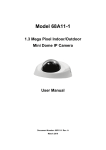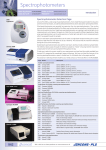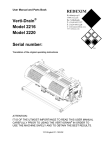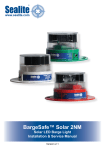Download BMW Master Cam Tools DIY
Transcript
Home
BMW Solutions
Porsche Solutions
DIY Tech
Engine Services
Dyno Services
Machining
About
Contact
Store
Tool Rental
G.A.S. BMW M62tu Master Cam Tools Instructions
Use these instructions only with the German Auto Solutions M62tu Master Cam Timing Tool Kit.
This procedure covers the replacement of timing chains, guides and tensioners, along with timing the VANOS on
the BMW M62-tu engine.
The following tools are required to complete this procedure. This list does not include any other tools that may be required to perform any
disassembly or reassembly prior to this procedure.
German Auto Solutions M62-tu Master Cam Timing Tool Kit.
32mm open end wrench or large adjustable wrench.
27mm open end wrench or large adjustable wrench.
24mm socket.
11mm socket.
10mm socket.
T55 Torx driver.
E12 Torx socket.
E10 Torx socket.
5mm Allen wrench or driver.
Appropriate ratchets for above sockets and drivers.
Multimeter with continuity mode.
Quality torque wrench with a working range of 10-100 ft/lbs.
Recommended M62tu parts replacement list with part numbers:
Part numbers listed are correct to the best of our knowledge at the time these instructions were written, we include them as a courtesy to our
customers and we take no responsibility for their accuracy! This list does not include any parts that may be required to perform any tasks that are
not directly a part of this procedure.
Required Part - Recommended Part
Primary timing chain - 11311741746
Primary timing chain tensioner guide rail - 11311741236
Primary timing chain fixed guide rail - 11311745406
Primary timing chain deflection guide rail - 11311741777
Secondary timing chain tensioner rail - 11311435028 - 4 required
Lower timing cover gasket set - 11141436978
Upper timing cover bank 1-4 gasket - 11141741532
Upper timing cover bank 5-8 gasket - 11141741533
Front oil pan gasket - 11131702891
Primary timing chain tensioner - 11317531813
Secondary timing chain bank 1-4 tensioner - 11311435026
Secondary timing chain bank 5-8 tensioner - 11311435027
Front main crankshaft seal - 11141275466
VANOS solenoid flange seal - 11141435023 - 2 required
Secondary timing chain - 11311747437 - 2 required
Valve cover gasket bank 1-4 - 11120034104
Valve cover gasket bank 5-8 - 11120034105
Spark plug valley cover gasket - 11121733969 - 2 required
Rubber valve cover nut gasket - 11121437395 - 16 required
Rubber valve cover bolt gasket - 11121721879 - 6 required
These instructions cover the replacement of the primary and secondary timing chains, timing chain guides and secondary chain tensioners. These
instructions also cover the timing of the VANOS system. These instructions assume a starting point that includes removal of all covers and
components required to gain access to the cam sprockets and primary timing chain. These instructions are specific to the German Auto Solutions
M62tu Cam Timing Tools only. If you have OEM BMW tools or another aftermarket brand of tools, these instruction will not apply to the use of those
tools.
****** IMPORTANT - IMPORTANT - IMPORTANT - IMPORTANT - IMPORTANT ******
Read the following four highlighted paragraphs before you begin any disassembly of your vehicle.
I HIGHLY recommend that you completely read through the entire instructions several times before you begin to
familiarize yourself with the procedure. Pay close attention to the first two steps, they will need to be performed during the
initial disassembly phase of the engine!
If you cannot have a computer nearby during this procedure, print off these PDF instructions. I highly recommend using a
laptop computer at the vehicle location if available over using the printed PDF instructions. The ability to enlarge the
pictures on a computer display will ensure that all the important detail information in the pictures will be visible.
DO NOT attempt to perform these instructions using a "Smart Phone"! The pictures contain important details that would
be very difficult to view properly on the small display of a smart phone.
Make sure that you read each step fully from beginning to end before you perform any part of a step. Some steps contain
multiple procedures, and some steps contain information at the end of the step, that is crucial to completing the step
properly. The only time anyone ever encounters a problem when using these instructions is when they start a step before
they have read the entire step through first.
Mouse over images in the instructions to view full size
I suggest you have a service manual on hand to guide you through the preliminary procedures that are not covered by these instructions. If you do
not have a service manual, below are links to sections of the BMW manual that cover disassembly procedures not covered by these instructions.
Removing and installing cylinder head covers
Removing and installing suction-filter housing
Replacing ignition coils
Removing and installing replacing vibration damper
Removing and installing replacing hub for vibration damper
Installing and removing replacing piston for chain tensioner
Removing and installing timing case cover, top left
Removing and installing timing case cover, top right
Removing and installing timing case cover, bottom
Removing and installing replacing upper section of oil pan
Removing and installing replacing lower oil pan section
Removing and installing or replacing fan coupling
This is the German Auto Solutions M62tu Master Cam Timing tool kit. These Instructions are
only for the use of the German Auto Solutions M62tu Master Tool Kit.
if you are using the German Auto Solutions M62tu Professional Cam Timing Tool Kit, please
refer to these instructions: GAS M62 Pro Tool Kit Instructions.
These are the tools required to perform the procedures described in these
instructions.
This procedure can be performed without a multimeter, but it is highly recommended
that you use one. These instructions cover VANOS timing with and without a
multimeter.
The tools are listed separately at the introduction to these instructions.
#!1
Steps 1-3 should already have been completed during removal of the timing covers,
balancer pulley and balancer hub. They are mentioned here to verify the required
starting conditions for these instructions.
You should have already aligned these timing marks before removal of the balancer.
Make sure that you have set cylinder number one piston at TDC (Top Dead Center)
of the compression stroke, and that you have installed the TDC flywheel lock pin that
comes with the kit.
#2
Verify that the lock pin is engaged by trying to rotate the crankshaft using a socket
and ratchet on the front balancer bolt. Use just enough force to verify that the pin is
engaged.
#3
This should be your starting point, with valve cover, accessories and all timing
covers removed, and the engine set at #1 cylinder TDC compression stroke.
#4
Remove the 10 hex nuts securing the cam journal oil feed lines, then remove the oil
feed lines from both cylinder banks.
#5
Cam journal oil feed lines removed.
The camshafts are marked with identification numbers.
The left hand side of the engine (as seen when facing the front of the engine) is bank
1-4 and the right side is bank 5-8.
#6
Intake cams are marked with the letter "E" and exhaust cams with the letter "A".
These markings will be important when choosing the proper cam lock blocks and
VANOS timing plates during this procedure.
With the crankshaft locked at #1 cylinder TDC position, your bank 1-4 and 5-8 cam
markings should be facing up. If the markings are facing down, rotate the crankshaft
one full revolution and reinstall the TDC lock pin. See step #70 for an easy way to
help find TDC again if you need to rotate the crank.
#7
The square boss on the end of the intake cam ("E") that the arrows are pointing to,
could be rotated clockwise from what is shown in the picture. The intake cam
rotation is dependant on the position of the intake VANOS unit. Anything from square
to the head surface to about 20 degrees clockwise rotation is normal.
The square boss on the end of the exhaust cam ("A") that the arrows are pointing to,
should appear to be rotated slightly clockwise from square to the head surface. This
is the normal timing position of the exhaust camshaft.
#8
>
The same description of cam positions for bank 1-4 applies to bank 5-8.
We will now start the disassembly of the primary timing chain guides.
#9
Note the twisted wire holding the tensioner chain guides together. A long zip tie is the
preferred method of securing the guide, but as you can see, even a piece of twisted
wire is fine during disassembly. Whatever you use, just make sure that it holds the
chain guides together tight enough so that you can remove the VANOS timing plate
nuts in the next step.
You will want to use quality zip ties during the assembly and timing phase of the
procedure.
#10
Start by removing the hex nut and VANOS timing plate on cylinder bank 1-4 with a
24mm socket or wrench.
Important! - Nut is left hand thread!
#11
Bank 1-4 nut and timing plate removed.
#12
You will now repeat the procedure on cylinder bank 5-8.
Remove the hex nut and timing plate on bank 5-8 with a 24mm socket or wrench.
#13
#14
Important! - Nut is left hand thread!
Bank 5-8 nut and timing plate removed.
In the following steps you will need to support the camshaft with a 27mm open end
or adjustable wrench placed over the cast hex shaped portion of the camshaft as
shown.
#15
Note: The cast hex on the intake and exhaust cams are in different positions. The
exhaust hex is close to the front of the cam and the intake hex is close to the rear
of the cam.
Important! - Bolt is left hand thread.
While supporting the exhaust camshaft with a 27mm or large adjustable wrench,
loosen the torx bolt on the exhaust cam sprocket of bank 5-8.
#16
Important! - Bolt is left hand thread.
Do not remove the sprocket bolt at this time.
Repeat the procedure on the exhaust cam bolt of the cylinder bank 1-4.
#17
#18
Important! - Bolt is left-hand thread.
Next we will loosen the bolts on the intake cam sprockets. Again, make sure that
you support the camshaft with a 27mm wrench or adjustable wrench.
This is bank 1-4.
Repeat the procedure on cylinder bank 5-8.
#19
Important - bolt is left hand thread.
A word about your German Auto Solutions Cam Lock Blocks
Your German Auto Solutions Cam Lock Blocks are made from aerospace grade aluminum alloy with the addition of a very hard anodized coating. If
you treat them properly they will last a lifetime. Once they are installed onto the cylinder head they are extremely strong and durable. The only
place you need to exercise special care is when installing or removing them from the camshafts.
The lock blocks are machined to a precision fit to the camshafts, and if installed correctly, will slip easily into place. If you do not line up the cams
properly and you try to force or pound the blocks into place you can damage the aluminum alloy under the hard coating. If the lock blocks do not
slide into place with very light hand pressure there is something wrong. Either there is damage to the end of the camshaft or you do not have the
cam positioned properly. Even a small nick on the square machined end of the camshafts can cause a problem. If they do not slide easily into
place, stop and find out why, then correct the problem.
Never try to rotate the cams with the lock blocks partially in place unless you are in the process of sliding them on or off!
You will now install the camshaft lock blocks stariting with cylinder bank 5-8.
#20
Start by making sure the square boss on the end of the intake cam is close to
square with head surface and that the "E" marking is facing up. Use a wrench on the
hex section of the cam to rotate the cam to the proper position.
Using a Lock Block marked "E", position the block with the T-slot in the block aligned
with the stud. If necessary rotate the camshaft with the wrench a little until the stud
is approximately centered in slot as shown, then slip the block into place.
Lightly push down on block until it seats against cylinder head surface. Rock the
camshaft a little back or forth if necessary until block sits flat to head.
#21
DO NOT FORCE OR POUND THE BLOCK INTO PLACE.
If everything is properly aligned the blocks will easily slide into place. If they don't,
find out why, do not force them down!
#22
Once the block is seated flat against head surface it should look like this, with the
stud centered in the T-slot.
Keep downward pressure on the block for the next step.
#23
Now slide the block toward the front of the engine until the stud stops against the
end of the T-slot. This fully engages the block over the square boss on the end of
the camshaft.
#24
While keeping downward pressure on the lock block, install the provided 6mm wing
nut and finger tighten.
We will now repeat the procedure on the exhaust camshaft. Exhaust cam pictures
lack the text of the intake cam pictures. The procedure is identical.
#25
Start by making sure the square boss on the end of the exhaust cam is close to
square with head surface and that the "A" marking is facing up. Use a wrench on the
hex section of the cam to rotate the cam to the proper position.
Using a Lock Block marked "A", position the block with the T-slot in block aligned
with the stud. If necessary rotate the camshaft with the wrench a little until the stud
is approximately centered in slot as shown, then slip the block into place.
Lightly push down on the block until it seats against cylinder head surface. Rock
camshaft a little back or forth if necessary until block sits flat to the head.
#26
DO NOT FORCE OR POUND BLOCK INTO PLACE.
If everything is properly aligned the blocks will easily slide into place. If they don't,
find out why, do not force them down!
#27
Once the block is seated flat against head surface it should look like this, with the
stud centered in the T-slot.
Keep downward pressure on the block for the next step.
#28
Now slide the block toward the front of the engine until the stud stops against the
end of the T-slot. This fully engages the block over the square boss on the end of
the camshaft.
#29
While keeping downward pressure on the lock block, install the provided 6mm wing
nut and finger tighten.
#30
Cam lock blocks properly installed.
#31
Now repeat the procedure on cylinder bank 5-8.
You are now going to remove the tensioner guide rail.
#32
#33
Remove the zip tie, or whatever you are using to support the tensioner guide, then
remove the guide pivot bolt with an E12 Torx socket.
Remove the tensioner guide rail by pulling at the bottom of the rail to free the oil
feed tube as shown.
Next you will remove the stationary guide rail.
#34
Remove the two hex bolts that secure the guide and oil separator unit using a 10mm
socket.
Some models do not use the oil separator and only have one bolt at this location.
#35
After removing the hex bolts, use a small flat blade screwdriver to pry the clip at the
bottom of the guide, then slide the guide from the retaining pins.
This is what the engine should look like at this point.
#36
#37
Next we'll remove the primary timing chain.
Release the primary chain from bank 1-4 intake cam sprocket, then remove entire
chain.
Remove the two 7mm torx bolts, and the three 6mm torx bolts securing the
U-shaped guide using an E10 Torx socket.
#38
#39
Once the bolts are removed, pull the guide toward you to remove. There is a tube
and O-ring at the bottom of the U-guide that may offer some resistance.
View of engine with all primary guides removed.
You will now remove the exhaust sprocket on bank 5-8.
Push down on tensioner rail at the location shown in picture until fully compressed,
then slide supplied retaining clip into place as shown. There is oil in the tensioner so
it may take a little force to fully compress.
#40
Used tensioner plastic rails are very brittle and can easily break at the little clip
holes if you are not careful. Don't worry if you break them, the procedure can easily
be accomplished without the clips. If you break the clip holes, just keep the
tensioner compressed by hand while removing the exhaust cam sprocket.
Remove exhaust cam sprocket bolt. Bolt should have been loosened in a previous
step.
#41
With the tensioner compressed, remove exhaust cam sprocket as shown.
#42
Exhaust cam sprocket removed.
Remove the two hex nuts securing the secondary tensioner unit with an 11mm
socket, then pull up on the tensioner to remove.
#43
There is a tube with an O-ring at the bottom of the tensioner that may offer some
resistance.
#44
Remove the intake cam sprocket bolt, then remove the intake cam sprocket and
secondary timing chain.
The bolt should have already been loosened in a previous step.
#45
Cam sprockets and secondary timing chain removed.
Repeat the process on cylinder bank 1-4.
#46
This is a really good time to carefully clean all of your gasket surfaces.
Now we will begin reassembly.
#47
Start by installing new secondary timing chains onto intake cam sprockets, then
slide sprockets onto the intake camshafts as shown.
Install torx head sprocket bolts finger tight, then back out 1/4 turn.
Compress your new secondary chain tensioners, then insert the locking clips from
your tool kit to keep them compressed.
#48
Install new secondary chain tensioners. Snug the two hex nuts on each tensioner
then torque the nuts to 19Nm -14ft/lbs.
If you have the tensioner locking clips install, don't forget to remove them.
#49
Loop the secondary timing chains over the exhaust cam sprockets, then slide the
sprockets into place as shown.
Installed torx head exhaust sprocket bolts finger tight, then back out 1/4 turn.
#50
#51
Next you will be installing your new U-shaped guide. Snug up the two 6mm and three
7mm bolts first. Then torque to 14Nm -10.3ft/lbs.
Snug this grub screw until it lightly contacts the oil separator unit. A drop of medium
strength "blue" threadlock is recommend here.
Some models do not use this grub screw.
#52
Next loop your new primary timing chain over the intake cam sprockets, under the
U-shaped guide, and under the crankshaft sprocket.
Make sure the chain is engaged with the crankshaft teeth before proceeding.
#53
Slide your new stationary chain guide over the two retaining pins until guide snaps
into place.
You will need to push the timing chain inward to clear the stationary guide.
Now install the two hex bolts at the top of the guide. Snug the two bolts, then torque
to 10Nm - 7.5ft/lbs.
#54
A drop of medium strength "blue" threadlock is recommend here.
Some models will only have one screw at this location.
You will now be installing the tensioner guide rail.
#55
Make sure the oil feed tube is lined up with the hole in the U-shaped guide, then
push bottom of guide into place. Rub a little bit of motor oil on to the O-ring before
installing the guide.
Install tensioner guide rail bolt, and torque to 22Nm - 16ft/lbs.
#56
#57
Install new zip tie at top of guide rail to temporarily hold guide rail in place.
Install the German Auto Solutions Tensioner Tool at the location shown using the
supplied 6mm bolts. Lightly snug the 6mm bolts to secure tensioner tool in place.
German Auto Solutions Tensioner Tool properly installed.
#58
Do not tighten the tensioner tool against the guide yet.
We will now set the initial primary chain tension.
#59
Grasp the tensioner guide rail and squeeze tightly against the U-shaped guide rail to
remove all chain slack. While tightly squeezing tensioner rail, pull the zip tie as tight
as it will go to secure rail in this position.
Now tighten tensioner tool thumbscrew until tensioner pin just contacts guide rail,
then tighten tensioner tool 2 more turns to set proper chain tension.
#60
I recommend squeezing the guide rail again while performing the first part of this
step, in case the zip tie has stretched.
The next procedure requires a universal multimeter, preferably with a audible
continuity function.
#61
Although not recommended, you can perform the VANOS timing without a multimeter.
If you are not using a meter, skip to step #64
We will start with cylinder bank 5-8.
#62
Start by setting your multimeter to the resistance function. If your meter has an
audible continuity option, turn that on.
Clip one lead of your multimeter to one of the pins on the VANOS sprocket. Connect
the other lead to any good ground location (clean part of the engine block or head).
#63
This is how your connections should look.
Using your German Auto Solutions VANOS adjusting wrench, you will be rotating the
inner section of the VANOS unit counterclockwise until the multimeter reads
continuity or an audible tone is heard.
#64
If you are not using a multimeter you will be rotating the inner section of the VANOS
unit counterclockwise until you feel a hard stop.
The two pins on the wrench insert into the holes in the VANOS unit. You can engage
the wrench at any angle that feels comfortable.
The VANOS unit will have oil remaining inside and may be difficult to turn until the oil
is purged. I like to rotate the unit back and forth a few times until I can feel the oil
has been purged from the unit. This is absolutely necessary if you are not using a
multimeter for this procedure.
#65
Once you can feel the oil has been purged from the unit, and it turns freely back and
forth, rotate CCW until continuity is measured or an audible tone is heard. You
should be able to feel a physical hard stop at the point where continuity is made.
If you are not using a multimeter just rotate CCW until you are sure you are up
against the hard stop.
#66
While holding CCW tension on the wrench and verifying continuity, snug the intake
cam sprocket bolt, but do not torque yet.
Important! - Left hand threads!
#67
After you have snugged, but not torqued the intake sprocket bolt, snug but do not
torque the exhaust sprocket bolt.
Important! - Left hand threads!
#68
Repeat the procedure with the VANOS unit and multimeter on cylinder bank 1-4
intake sprocket and snug, but do not torque the intake cam bolt.
#69
Repeat the procedure on cylinder bank 1-4 exhaust cam sprocket and snug, but do
not torque the exhaust cam bolt.
Optional but recommended step!
This is a bit of a pain, but if you want to be absolutely sure of your VANOS timing, I
recommend this step.
Since the timing chain and guides tend to settle into place a little when the
crankshaft is rotated, it's a good idea to manually turn the engine over then re-set
the timing.
#70
Remove the TDC lock pin and ALL cam lock blocks, then rotate the crankshaft
CLOCKWISE (as facing the front of the engine) 720 degrees (two complete
revolutions) until the cams end up back to their starting position. While rotating the
crankshaft, try to lightly increase the tension on the timing chain tensioner tool
thumbscrew. The thumbscrew will usually easily turn another 1/2 turn or so while
you are applying rotating force on the crankshaft. You do not need to over tighten
the thumbscrew, if it doesn't turn easily, don't force it. Verify the camshaft markings
again with steps #7 and #8 then reinstall the TDC lock pin.
Loosen, but do not remove, the intake and exhaust cam sprocket Torx head bolts.
Set the bolts finger tight, then back them out 1/4 turn. Install the cam lock blocks
again using steps #20 - #31, then repeat VANOS timing steps #62 - #69.
You can use the picture at left to mark the crankshaft to make it easier to find TDC
again after you rotate the crankshaft.
You will now torque the intake cam sprocket bolts. Make sure to support the
camshafts with a wrench on the hex section of the cams while torquing. Do not
apply the tightening torque against the cam lock blocks.
#71
Torque the intake cam bolts on both cylinder banks to 110Nm - 81ft/lbs.
Important! - Left hand threads!
You will now torque the exhaust cam sprocket bolts. Make sure to support the
camshafts with a wrench on the hex section of the cams while torquing. Do not
apply the tightening torque against the cam lock blocks.
#72
Torque the exhaust cam bolts on both cylinder banks to 125Nm - 92ft/lbs.
Important! - Left hand threads!
Remove the VANOS solenoids on both cylinder banks using a 32 mm wrench or a
large adjustable wrench.
#73
#74
If you followed the BMW front timing cover disassembly instructions you may have
already removed these.
Install the German Auto Solutions VANOS alignment threaded tool into the two
VANOS solenoid locations.
#75
Threaded alignment tool properly installed in cylinder bank 1-4.
#76
Threaded alignment tool properly installed in cylinder bank 5-8.
Install the VANOS timing plate and hex nut onto bank 1-4 intake cam.
#77
Position timing plate as shown and finger tighten the hex nut, then loosen the nut
1/4 turn.
Important! - Left hand threads!
Install the VANOS timing plate and hex nut onto bank 5-8 intake cam.
#78
Position timing plate as shown and finger tighten the hex nut, then loosen the nut
1/4 turn.
Important! - Left hand threads!
Start with cylinder bank 5-8.
Make sure that the 5-8 markings on the German Auto Solutions timing tool are
facing outward.
#79
Rotate the VANOS timing plate until the pin on the timing tool will slip into the slot in
the timing plate, then slip the timing plate into place as shown.
The hole in the bottom of the timing plate is a very close precision fit to the boss on
the threaded tool. It will only slip into place when lined up properly. Do not force or
pound the timing plate into position. If it doesn't slide on with finger pressure, it's not
lined up properly.
With VANOS timing tool engaged with timing plate, snug the timing plate hex nut,
then torque to 40Nm - 30ft/lbs.
#80
It's preferred to support the cams with a wrench on the hex section of the cam while
you torque the nut, but it isn't absolutely necessary. The cam lock blocks will support
the 30 ft/lb torque spec.
Important! - Left hand threads!
Move to cylinder bank 1-4.
Make sure that the 1-4 markings on the German Auto Solutions timing tool are
facing outward.
#81
Rotate the VANOS timing plate until the pin on the timing tool will slip into the slot in
the timing plate, then slip the timing plate into place as shown.
The hole in the bottom of the timing plate is a very close precision fit to the boss on
the threaded tool. It will only slip into place when lined up properly. Do not force or
pound the timing plate into position. If it doesn't slide on with finger pressure, it's not
lined up properly.
With VANOS timing tool engaged with timing plate, snug the timing plate hex nut,
then torque to 40Nm - 30ft/lbs.
#82
It's preferred to support the cams with a wrench on the hex section of the cam while
you torque the nut, but it isn't absolutely necessary. The cam lock blocks will support
the 30 ft/lb torque spec.
Important! - Left hand threads!
You are now finished with the parts replacement and VANOS timing.
#83
Remove all cam lock blocks and the G.A.S timing chain tensioner tool. Wire or zip
tie the chain guides together again until you put the front timing covers back on.
Remove TDC lock pin tool.
#84
Murphy's law states that at this point you should rotate the crankshaft a couple of
revolutions by hand to verify that nothing is binding. If you feel any binding, (it
should feel like it did before you started to take anything apart), stop and find out
why before you reassemble everything and attempt to fire the engine.
Thank you for choosing German Auto Solutions Tools.
Content copyright 2013. GermanAutoSolutions.COM. All rights reserved.
































![Installation Manual [PDF 3.1 MB]](http://vs1.manualzilla.com/store/data/006000040_1-a740b84bcdd0f591a4a671097fdfa72a-150x150.png)
